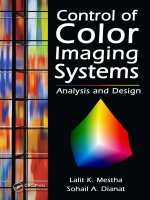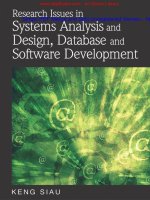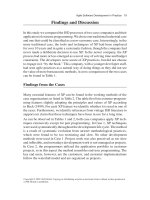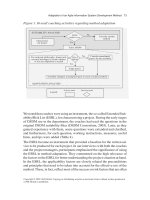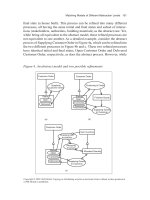Information Systems Analysis and Design doc
Bạn đang xem bản rút gọn của tài liệu. Xem và tải ngay bản đầy đủ của tài liệu tại đây (3.16 MB, 371 trang )
Information Systems
Analysis and Design
Lê Ngọc Tiến
2
Outline
1. Information Systems: the big picture
2. Information Systems for competitive advantage
3. Organizational Information Systems
4. Entreprise-Wide Information Systems
5. Information Systems Development & Acquisition
6. Managing the Information Systems Project
7. Systems Planning
8. Determining System Requirements
9. Structuring System Requirements: Process Modeling
10. Structuring System Requirements: Conceptual Data Modeling
11. Object Oriented Analysis and Design
12. Designing the Human Interface
13. Systems Implementation and Operation
Chapter 1
Information Systems:
The Big Picture
4
Chapter 1 Objectives
Understand the term information systems (IS)
Understand IS components:
Technology, people, organizations
Understand IS career opportunities
Understand types of information systems
Understand IS and organizational success or failure
Understand the future of IS management
5
Information Systems Defined
Combinations of hardware, software, and
telecommunications networks that people
build and use to collect, create, and distribute
useful data in organizations
6
Key Elements of Information Systems
7
Data
Data: raw material, unformatted information
Information: processed data (meaningful)
Knowledge: understanding relationships
between pieces of information
Wisdom: knowledge accumulated and applied
8
Knowledge as a Business Resource
Knowledge Worker
A well-educated professional who creates,
modifies, or synthesizes knowledge in one’s
profession
Knowledge Society
Also called digital society, new economy
Working with brains instead of hands
The importance of education
Digital divide
9
Technology and Information Systems
Computer-Based Information Systems
One type of technology
Technology – any mechanical and/or electrical means to
supplement, extend, or replace human activity
Information Technology (IT) – machine technology
controlled by or using information
The goal of IS is to provide useful data to users
IS can be local or global, organizational or enterprise-wide
10
IS Managerial Personnel
CIO
IS director
Account Executive
Info Center Manager
Development Manager
Project Manager
Maintenance Manager
Systems Manager
IS planning Manager
Operations Manager
Programming Manager
Systems Programming
Manager
Manager of Emerging
Technologies
Telecommunications
Manager
Network Manager
Database Administrator
Auditing or Computer
Security Manager
Quality Assurance Manager
Webmaster
11
Integrating Skills and Knowledge
Technology
hardware, software, networking
Business
business, management, social, communications
Systems
Integration, development methods, critical
thinking, problem solving
12
Hot Skills in IS Workers
Office / E-mail
Languages
Applications
RDBS Administration
Development Tools
Internetworking
Operating Systems
LAN Administration
Networking
13
IS Within the Firm
Traditionally a love/hate relationship
“Techies” vs. mere “users” (us vs. them)
Poor service, lousy attitudes
Now: progress toward better customer
service
Better relationships within the company
Cooperation, not rivalry
14
The Spread of Technology in Organizations
Technology infiltrates business units
Dual role for IS workers:
Work with IS technical group
Work with business unit (marketing, finance, etc.)
15
The Spread of Technology in Organizations
Benefits of centralized IS function
Coordinated planning
Consistent management
Systems compatibility and connectivity
16
Questions
1. Define and understand the term information
systems (IS)
2. Explain the technology, people, and
organizational components of an information
system.
Chapter 2
Information Systems for Competitive
Advantage
18
Chapter 2 Objectives
Understand the IS in automation,
organizational learning, and strategic support
Understand IS for strategic organizational
success
Understand the need for making an IS
business case
Understand technological innovations to
improve competitive advantage
19
Why Use Information Systems?
Automating: doing things faster
Organizational learning: doing things better
Supporting Strategy: doing things smarter
20
Automating:
Doing Things Faster
Technology is used to automate a manual
process
Doing things faster, better, cheaper
Greater accuracy and consistency
Loan application example
Manual processing
Technology-supported process
Completely automated
21
Organizational Learning:
Doing Things Better
Going beyond automation
Involves learning to improve the day-to-day activities within
the process
Looking at patterns and trends
Organizational Learning
Using acquired knowledge and insights to improve
organizational behavior
Total Quality Management (TQM)
Monitoring an organization to improve quality of operations,
products, and services
22
Supporting Strategy:
Doing Things Smarter
Strategic Planning
Create a vision: setting the direction
Create a standard: performance targets
Create a strategy: reaching the goal
23
Question
Now, it should be fairly obvious why an IS
professional should be able to make a business
case for a given system. Why, however, is it just as
important for non-IS professionals? How are they
involved in this process? What is their role in
information systems planning?
Chapter 3
Organizational
Information Systems
25
Chapter Objectives
Understand characteristics of operational,
managerial, and executive information systems
Understand characteristics of transaction processing
systems, management information systems, and
executive information systems
Understand characteristics of information systems
that span organizational boundaries



